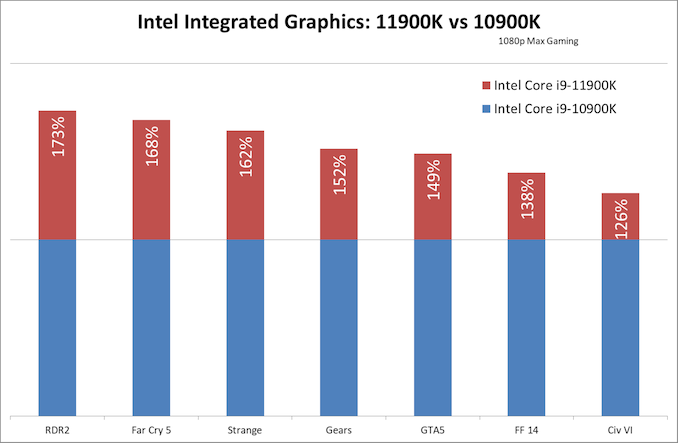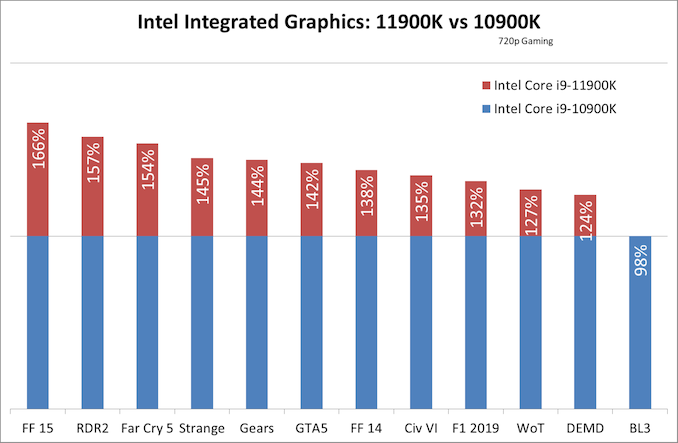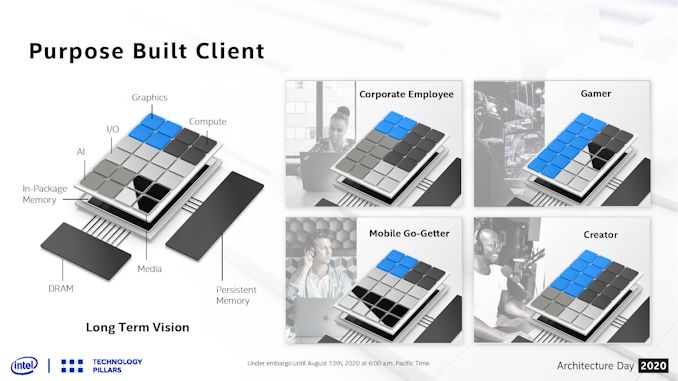Intel’s Integrated Graphics Mini-Review: Is Rocket Lake Core 11th Gen Competitive?
by Dr. Ian Cutress on May 7, 2021 10:20 AM ESTConclusions
No-one ever said that integrated graphics solutions had to be good. Nonetheless there is always the desire for something better, something higher performance, and something suitable for end-users. At the beginning of the era of integrated graphics, the focus was on simply providing something basic for 2D work - applications on an operating system and no real graphics rendering to mention. That solution is simple enough, however the demand on integrated graphics has grown over time, especially as the demands we put on our devices have also grown.
A modern system, especially a commercial system or one designed for work, has to do it all. Anyone not working in graphics might depend on a integrated solution to navigate complex arty web interfaces for the tool they use, or rely upon the acceleration features now baked into those platforms. Also perhaps, from time to time, some mild gaming use as well, if not outright using the compute features of the graphics for transcoding or AI. These demands are most heavily focused on mobile platforms, and as a result mobile platforms from Intel tend to get the best integrated graphics solutions, especially in thin-and-light designs where a discrete graphics solution is too power hungry. Intel's mobile Tiger Lake-U series offers a sizeable 96 execution units of the latest generation graphics architecture, compared to the desktop processors we are testing today, that only have 32.
So what use is a desktop processor with integrated graphics?
AMD and Intel both have product lines with integrated graphics. From Intel, its integrated graphics is in almost everything that Intel sells for consumers. AMD used to be that way in the mid-2010s, until it launched Ryzen, and now we have separate CPU-only and CPU+Graphics options. This is where the company philosophy differs.
AMD's desktop processors with integrated graphics are primarily intended to be a whole system replacement, with users relying on the integrated graphics for all their graphics needs. As a result AMD puts a lot more processing hardware into its integrated graphics solutions for the desktop, and it results in a good gaming experience for entry level gaming.
Intel's route on the otherhand is a bit more basic. The desktop integrated graphics here has two main directions: first, as the basic graphics needed for an office system, or second, more of a fall-back option for when the discrete card doesn't work or fails in more premium desktop systems. The power isn't there for hardcore grunt like gaming of any serious note, but it is certainly enough to cover the basics.
Despite this, with the new Xe-LP graphics solution, Intel has some aces up its sleeve. First is AV1 decoding, which allows users to watch AV1 content without putting stress on the CPU. Second is video encoding accelerationt through QuickSync, which has actually been a part of Intel's graphics for a number of years. Third is a relatively new feature: Intel's 'additional processor' mentality. Normally when a system has a discrete graphics card, the integrated graphics is disabled. But now, with its latest mobile devices for example, when Intel pairs its mobile processor with integrated graphics with a second graphics solution at about the same performance, with the right software Intel allows both graphics to work asynchrouusly on two different problems. The limit to this in the past has been dictating which graphics is the video out rather than simply a compute accelerator, but Intel believes it has worked it out. However, this is relatively little use for gaming, the topic of today.
Results Summary
In this review, we highlighted that Intel has now implemented its new Xe-LP graphics architecture onto its desktop processor line, and tested the new solutions against our traditional CPU gaming test suite. What we saw, in terms of a generational uplift from the i9-10900K to the i9-11900K, is actually quite impressive:
In our 720p testing, there's a clear generational gain across the board for Rocket Lake, and in most cases the games become a lot more playable. The average gain is 39%. If we flip to our gaming results at the higher resolution and settings:

Games with under 10 FPS across the board are left out
For these titles, the average gain is 153%, showing that Xe-LP is certainly a step up regardless of the workload.
The Future of Integrated Graphics
A key talking point about integrated graphics is whether a company should leverage a strong CPU product at the expense of graphics, or aim for something with strong integrated graphics as a more complete chip at the expense of the mid-range graphics market. The console market for example relies fully on integrated graphics designs, especially as it keeps the manufacturing simpler and number of chips lower. But on the desktop space, because discrete graphics are an option (well, when we're not in a mining craze or semiconductor shortage), there seems to be no impetus for companies to do a full fat integrated graphics solution that competes on the same stage as a mid-range graphics card. AMD could do it, but it might overlap with their console agreements, and Intel hasn't done anything serious since Broadwell.
To put a nod to Broadwell, Intel's 5th Gen processor. It was so powerful at integrated graphics at the time, we are still using it today as a comparison point when comparing against other Intel solutions. Broadwell had dedicated 48% of the die area of its top processor to graphics, and for that product it also added some really fast cache memory as well. Intel's focus on integrated graphics as a function of die size has decreased over time, now with Rocket Lake sits at around 20% of the silicon. It hasn't been this low since Intel first introduced its integrated graphics solutions. For that 20%, we get 32 execution units with eight processing cores. Tiger Lake has 96 EUs which total around 33% of overall die size, but has four cores. If Intel was focused on graphics performance in the same way as it was in Broadwell, we might be looking at a 256+ EU solution.
With Intel taking a renewed approach to graphics with its Xe portfolio, stemming from entry up to high performance compute, there is room here for Intel to develop integrated graphics focused solutions. Intel has detailed that it is moving to chiplets with its future mainstream processors under its 'Client 2.0' strategy, and part of that is allowing customers to select how many IP blocks they want of cores, IO, memory, security, and graphics. In the image above, the Gamer option has half of the die area for graphics. This could at the end of the day be a target that could see Intel making desktop integrated graphics a focus again.












165 Comments
View All Comments
ballsystemlord - Monday, May 10, 2021 - link
That's the new spec. ATX 12v only https://en.wikipedia.org/wiki/ATX#ATX12VO. It's not proprietary stuff. It's just increasing the efficiency of the PSU because of regulations around climate change "It was motivated by stricter power efficiency requirements by the California Energy Commission going into effect in 2021." -- see above link.Ultimately, they are just transferring the electrical inefficiencies to the MB. Thus demonstrating once again that the solution really doesn't solve anything -- just like solar panels and battery powered cars.
Spunjji - Tuesday, May 11, 2021 - link
@ballsystemlord They were talking about a Haswell system, so it's not the new ATX12VO spec as that wasn't finalised until 2019. Dell have had proprietary pin-outs on their PSUs for decades now.That 12VO description is a little bit of an oversimplification, too. Aside from simplifying connector design, it saves on materials costs for power supplies - no need to build circuits for conversion to every voltage a PC might need when many won't even use those circuits (e.g. an ITX gaming PC that only uses NVMe storage). Having drives powered from the board also simplifies cabling - you just run one power+storage connector from the board, instead of threading from both the motherboard and the PSU.
ballsystemlord - Thursday, May 13, 2021 - link
@Spunjji Thanks! I wouldn't have thought to check the release year of the products compared to the spec if you hadn't said anything!Oxford Guy - Sunday, May 9, 2021 - link
Corporations do their best to create the products they want to sell rather than the products people want to buy.Spunjji - Monday, May 10, 2021 - link
Dell have had proprietary components on their motherboards for decades - I remember trying to repair a Pentium 4-based Dell desktop and discovering that I had to *re-wire the 20-pin PSU connector* because they used a nonstandard pin-out. And don't get me started on their front panel connectors... they used to leave the AGP ports off the boards so they couldn't be upgraded with decent graphics adaptors, too.GeoffreyA - Monday, May 10, 2021 - link
Even Compaq too. I've got a Coppermine which I'd like to fire up for the fun of it, but the PSU is blown, and if I remember rightly, it's got a nonstandard connector.Spunjji - Tuesday, May 11, 2021 - link
@GeoffreyA - if you ever feel like getting creative, it looks like people have documented the pin-outs and the changes needed to replicate them with a standard PSU:https://www.ecoustics.com/electronics/forum/comput...
GeoffreyA - Wednesday, May 12, 2021 - link
Thanks for the link.ballsystemlord - Monday, May 10, 2021 - link
Contrary to Nvidia's marketing materials, it's not that big of an uplift. The big GPU uplift has been from Navi -- and just like ryzen's uplift, this is due to AMD being so far behind.Gigaplex - Saturday, May 8, 2021 - link
B550 in general officially doesn't support the 3200G. That's not really an HP thing. The 4000 series though... Ouch.